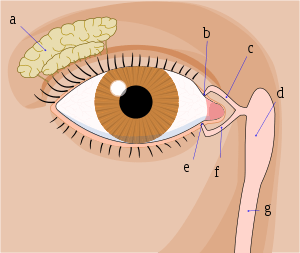Tears
Tears are a clear liquid secreted by the lacrimal glands (tear gland) found in the eyes of all land mammals (except for goats and rabbits).[1][2] Their functions include lubricating the eyes (basal tears), removing irritants (reflex tears), and aiding the immune system.[3] Tears also occur as a part of the body's natural pain response.[4] Humans are the only mammals known to produce tears as part of an emotional response, such as out of joy or grief. Tears have symbolic significance among humans (see crying).[4] Emotional secretion of tears may serve a biological function by excreting stress-inducing hormones built up through times of emotional distress.[5][6] Tears are made up of water, electrolytes, proteins, lipids, and mucins that form layers on the surface of eyes.[7] The different types of tears—basal, reflex, and emotional—vary significantly in composition.[7]

- a) Lacrimal gland
- b) Superior lacrimal punctum
- c) Superior lacrimal canal
- d) Lacrimal sac
- e) Inferior lacrimal punctum
- f) Inferior lacrimal canal
- g) Nasolacrimal canal
Physiology
Chemical composition
Tears are made up of three layers: lipid, aqueous, and mucous.[8] Tears are composed of water, salts, antibodies, and lysozymes (antibacterial enzymes), though composition varies among different tear types. The composition of tears caused by emotion differs from that of tears as a reaction to irritants, such as onion fumes, dust, or allergy. Emotional tears contain higher concentrations of stress hormones such as adrenocorticotropic hormone and leucine enkephalin (a natural pain killer), which suggests that emotional tears play a biological role in balancing stress hormone levels.[9]
| Name | Contents | Secretors | Functions |
|---|---|---|---|
| Lipid layer | Oils | Meibomian glands (or tarsal glands) | Coats the aqueous layer, provides a hydrophobic barrier that envelops tears and prevents their spilling onto the cheek. These glands are located among the tarsal plates, and thus deposit the tear fluid between the eye proper and the oil barriers of the lids.[7] |
| Aqueous layer | Electrolytes, 60 metabolites—Amino Acids (1-Methylhistidine/3-Methylhistidine, Arginine, Asymmetric, Asymmetric dimethylarginine/Symmetric dimethylarginine, Citrulline, Creatine, Glutamine, Homoarginine, Hydroxyproline, Phenylalanine, Proline, Pyroglutamic acid, Serine, Taurine, Theonine, Tryptophan, Tyrosine, Urocanic acid, Valme), Amino Alcohols (Panthenol), Amino Ketones (Allantoin, Creatine), Aromatic Acids (Cinnamic acid, o-Coumaric acid/m-Coumaric acid/p-Coumaric acid), Carbohydrates (N-Acetylneuraminic acid), Carnitines (Acetylcarnitine, Carnitine, hexanoylcarnitine, Palmitoylcarnitine), Cyclic Amines (Niacinamide), Dicarboxylic Acids (Fumaric acid/ Maleic acid), Nucleosides (1-Methyladenosine, Adenosine, Cytidine, Guanosine, Inosine, S-Adenosyl-homocysteine, S-Adenosylmethionine, Uridine, and Xanthosine), Nucleotides (ADP, AMO, CMP, Cytidine diphosphate choline, GMP, IMP, UDP, UMP, UDP-N-acetylgalactosamine/UDP-N-acetylglucosamine), Peptides (Oxidized glutathione), Phospholipids (1-Palmitoyl-lysophosphatidylcholine), Purines and derivatives (Hypoxanthine, Theobromine, Uric acid, Xanthine), Purines and derivatives (4-Pyridoxic acid), Quaternary Amines (Acetylcholine, Glycerophosphocholine, Phosphocholine), and Tricarboxylic Acids (Citric acid), and other substances such as proteins (e.g., antibodies,[8] lipocalin, lactoferrin, lysozyme,[10] and lacritin) | Lacrimal gland | Promotes spreading of the tear film, the control of infectious agents, and osmotic regulation. |
| Mucous layer | Mucins | Conjunctival goblet cells | Coats the cornea, provides a hydrophilic layer and allows for even distribution of the tear film. |
Drainage of tear film
The lacrimal glands secrete lacrimal fluid, which flows through the main excretory ducts into the space between the eyeball and the lids.[11] When the eyes blink, the lacrimal fluid is spread across the surface of the eye.[11] Lacrimal fluid gathers in the lacrimal lake which is found in the medial part of the eye. The lacrimal papilla is an elevation in the inner side of the eyelid, at the edge of the lacrimal lake.[11] The lacrimal canaliculi open into the papilla.[11] The opening of each canaliculus is the lacrimal punctum. From the punctum, tears will enter the lacrimal sac,[7] then on to the nasolacrimal duct, and finally into the nasal cavity.[11] An excess of tears, as caused by strong emotion, can cause the nose to run. Quality of vision is affected by the stability of the tear film.[12]
Types
There are three basic types of tears: basal, reflex and emotional.[3]
| Category | Description |
|---|---|
| Basal tears | In healthy mammalian eyes, the cornea is continually kept wet and nourished by basal tears. They lubricate the eye and help keep it clear of dust. Tear fluid contains water, mucin, lipids, lysozyme, lactoferrin, lipocalin, lacritin, immunoglobulins, glucose, urea, sodium, and potassium. Some of the substances in lacrimal fluid (such as lysozyme) fight against bacterial infection as a part of the immune system. Lysozyme does this by dissolving a layer in the outer coating, called peptidoglycan, of certain bacteria. It is a typical body fluid with salt content similar to blood plasma. Usually, in a 24-hour period, 0.75 to 1.1 grams (0.03–0.04-ounce avoirdupois) of tears are secreted; this rate slows with age.[7] In addition, the basal tears are composed of antioxidants such as Ascorbate, Urate, Cysteine, Glutathione, and Tyrosine. Ascorbate and Urate constitute half of the tears. |
| Reflex tears | The second type of tears results from irritation of the eye by foreign particles, or from the presence of irritant substances such as onion vapors, perfumes and other fragrances, tear gas, or pepper spray in the eye's environment, including the cornea, conjunctiva, or nasal mucosa, which trigger TRP channels in the ophthalmic nerve. It can also occur with bright light and hot or peppery stimuli to the tongue and mouth. It is also linked with vomiting, coughing, and yawning.[7] These reflex tears attempt to wash out irritants that may have come into contact with the eye. |
| Emotional Tears (psychic tears) | The third category, in general, referred to as crying or weeping, is increased tearing due to strong emotional stress, pleasure, anger, suffering, mourning, or physical pain. This practice is not restricted to negative emotions; many people cry when extremely happy, such as times of intense humor and laughter. In humans, emotional tears can be accompanied by reddening of the face and sobbing — cough-like, convulsive breathing, sometimes involving spasms of the whole upper body. Tears brought about by emotions have a different chemical makeup than those for lubrication; emotional tears contain more of the protein-based hormones prolactin, adrenocorticotropic hormone, and Leu-enkephalin (a natural painkiller) than basal or reflex tears. The limbic system is involved in the production of basic emotional drives, such as anger, fear, etc. The limbic system, or, more specifically the hypothalamus, also has a degree of control over the autonomic system. The parasympathetic branch of the autonomic nervous system controls the lacrimal glands via the neurotransmitter acetylcholine through both the nicotinic and muscarinic receptors. When these receptors are activated, the lacrimal gland is stimulated to produce tears.[13] |

Neurology
The trigeminal V1 (fifth cranial) nerve bears the sensory pathway of the tear reflexes. When the trigeminal nerve is cut, tears from reflexes will stop, while emotional tears will not. The great (superficial) petrosal nerve from cranial nerve VII provides autonomic innervation to the lacrimal gland.[14] It is responsible for the production of much of the aqueous portion of the tear film.
Human culture

In nearly all human cultures, crying is associated with tears trickling down the cheeks and accompanied by characteristic sobbing sounds. Emotional triggers are most often sadness and grief, but crying can also be triggered by anger, happiness, fear, laughter or humor, frustration, remorse, or other strong, intense emotions. Crying is often associated with babies and children. Some cultures consider crying to be undignified and infantile, casting aspersions on those who cry publicly, except if it is due to the death of a close friend or relative. In most Western cultures, it is more socially acceptable for women and children to cry than men, reflecting masculine sex-role stereotypes.[15] In some Latin regions, crying among men is more acceptable.[16][17][18] There is evidence for an interpersonal function of crying as tears express a need for help and foster willingness to help in an observer.[15]
Some modern psychotherapy movements such as Re-evaluation Counseling encourage crying as beneficial to health and mental well-being. [19] An insincere display of grief or dishonest remorse is sometimes called crocodile tears in reference to an Ancient Greek anecdote that crocodiles would pretend to weep while luring or devouring their prey.[20] In addition, "crocodile tears syndrome" is a colloquialism for Bogorad's syndrome, an uncommon consequence of recovery from Bell's palsy in which faulty regeneration of the facial nerve causes sufferers to shed tears while eating.[21][22]
Pathology
Bogorad's syndrome
Bogorad's syndrome, also known as "Crocodile Tears Syndrome", is an uncommon consequence of nerve regeneration subsequent to Bell's palsy or other damage to the facial nerve. Efferent fibers from the superior salivary nucleus become improperly connected to nerve axons projecting to the lacrimal glands, causing one to shed tears (lacrimate) on the side of the palsy during salivation while smelling foods or eating. It is presumed that this would cause salivation while crying due to the inverse improper connection of the lacrimal nucleus to the salivary glands, but this would be less noticeable.[21][22] The condition was first described in 1926 by its namesake, Russian neuropathologist F. A. Bogorad, in an article titled "Syndrome of the Crocodile Tears" (alternatively, "The Symptom of the Crocodile Tears") that argued the tears were caused by the act of salivation.[23][24]
Keratoconjunctivitis sicca (dry eye)
Keratoconjunctivitis sicca, known as dry eye, is a very common disorder of the tear film. Despite the eyes being dry, sufferers can still experience watering of the eyes, which is, in fact, a response to irritation caused by the original tear film deficiency. Lack of Meibomian gland secretion can mean the tears are not enveloped in a hydrophobic film coat, leading to tears spilling onto the face.
Treatment for dry eyes to compensate for the loss of tear film include eye-drops composed of methyl cellulose or carboxy- methyl cellulose or hemi-cellulose in strengths of either 0.5% or 1% depending upon the severity of drying up of the cornea.
Familial dysautonomia
Familial dysautonomia is a genetic condition that can be associated with a lack of overflow tears (Alacrima) during emotional crying.[25]
Obstruction of the punctum, nasolacrimal canal, or nasolacrimal duct can cause even normal levels of the basal tear to overflow onto the face (Epiphora), giving the appearance of constant psychic tearing. This can have significant social consequences.
Pseudobulbar affect
Pseudobulbar affect (PBA) is a condition that is characterized by episodes of uncontrollable laughter or crying. It mostly occurs in people suffering from certain neurological injuries that affect the way their brain controls emotions.[26] Scientists believe PBA may be a result of damage to the prefrontal cortex, which is the area of the brain that controls emotions.[27] Because PBA often involves crying, the condition may be mistaken for depression. However, PBA is a neurological condition, while depression is psychological.[28] People suffering from PBA do not experience some of the typical depression symptoms such as sleep disturbances or loss of appetite.
See also
| Wikimedia Commons has media related to Tears. |
References
- "Definition of TEAR". www.merriam-webster.com. Retrieved 2019-08-04.
- "Animals With No Tear Ducts". animals.mom.me. Retrieved 2019-08-04.
- Farandos, NM; Yetisen, AK; Monteiro, MJ; Lowe, CR; Yun, SH (2014). "Contact Lens Sensors in Ocular Diagnostics". Advanced Healthcare Materials. 4 (6): 792–810. doi:10.1002/adhm.201400504. PMID 25400274.
- "Why do we cry? The scientific reasons behind sobbing". The Independent. 2014-09-18. Retrieved 2019-08-04.
- "All About Emotional Tears". American Academy of Ophthalmology. 2017-02-28. Retrieved 2019-08-04.
- Frey, W. H.; DeSota-Johnson, D.; Hoffman, C.; McCall, J. T. (October 1981). "Effect of stimulus on the chemical composition of human tears". American Journal of Ophthalmology. 92 (4): 559–567. doi:10.1016/0002-9394(81)90651-6. ISSN 0002-9394. PMID 7294117.
- "eye, human."Encyclopædia Britannica from Encyclopædia Britannica 2006 Ultimate Reference Suite DVD 2009
- Moshirfar M, Pierson K, Hanamaikai K, Santiago-Caban L, Muthappan V, Passi SF (July 2014). "Artificial tears potpourri: a literature review". Clin Ophthalmol. 8: 1419–33. doi:10.2147/OPTH.S65263. PMC 4124072. PMID 25114502.
- Frey, William H.; Desota-Johnson, Denise; Hoffman, Carrie; McCall, John T. (October 1981). "Effect of Stimulus on the Chemical Composition of Human Tears". American Journal of Ophthalmology. 92 (4): 559–567. doi:10.1016/0002-9394(81)90651-6. PMID 7294117.
- "Ocular Pathology Study Guide: Tear Proteins". medrounds.org. Archived from the original on 2006-06-27.
- "Tears". Target Health Blog. July 2, 2018. Retrieved 2019-07-07.
- Szczesna DH, Jaroński J, Kasprzak HT, Stenevi U (2006). "Interferometric measurements of dynamic changes of tear film". J Biomed Opt. 11 (3): 34028. Bibcode:2006JBO....11c4028S. doi:10.1117/1.2209881. PMID 16822077. Archived from the original on 2012-07-13.
- Skorucak A. "The Science of Tears." ScienceIQ.com. Accessed September 29, 2006.
- Dartt, D. A. (2009). "Neural Regulation of Lacrimal Gland Secretory Processes: Relevance in Dry Eye Diseases". Progress in Retinal and Eye Research. 28 (3): 155–177. doi:10.1016/j.preteyeres.2009.04.003. PMC 3652637. PMID 19376264.
- Stadel, M; Daniels, JK; Warrens, MJ; Jeronimus, BF (2019). "The gender-specific impact of emotional tears". Motivation and Emotion. 1 (1): 696–704. doi:10.1007/s11031-019-09771-z.
- Dianne Hales (October 2005). "Big Boys Don't Cry — and Other Myths About Men and Their Emotions (page 2 of 3)". Reader's Digest. Archived from the original on January 17, 2009. Retrieved 2008-07-20.
- Fran Metcalf (8 May 2008). "These days it's OK for men to cry, say famous guys". The Courier Mail. Retrieved 3 June 2015.
- John-Paul Flintoff (August 30, 2003). "Why we cry". The Age. Retrieved 2008-07-20.
- "Re-evaluation Counseling".
- "No Faking It, Crocodile Tears Are Real". ScienceDaily. Retrieved 2019-06-18.
- Morais Pérez D, Dalmau Galofre J, Bernat Gili A, Ayerbe Torrero V (1990). "[Crocodile tears syndrome]". Acta Otorrinolaringol Esp (in Spanish). 41 (3): 175–7. PMID 2261223.
- McCoy, FJ; Goodman, RC (Jan 1979). "The crocodile tear syndrome". Plastic and Reconstructive Surgery. 63 (1): 58–62. doi:10.1097/00006534-197901000-00010. PMID 432324.
- F. A. Bogorad (trans Austin Seckersen), "The symptom of crocodile tears", Journal of the History of Medicine and Allied Sciences, 02/1979; 34(1):74-9.
- Lester Allen Russin, "Paroxysmal Lacrimation During Eating as a Sequal of Facial Palysyndrome of Crocodile Tears", JAMA. 1939;113(26):2310-2311.
- Felicia B Axelrod; Gabrielle Gold-von Simson (October 3, 2007). "Hereditary sensory and autonomic neuropathies: types II, III, and IV". Orphanet Journal of Rare Diseases. 2 (39): 39. doi:10.1186/1750-1172-2-39. PMC 2098750. PMID 17915006.
- "Pseudobulbar affect - Symptoms and causes". Mayo Clinic. Retrieved 2019-06-18.
- "Pseudobulbar Affect: What Is It?". WebMD. Retrieved 2019-06-18.
- "About PBA". PBA Info. 2014-03-10. Retrieved 2019-06-18.
External links
| Wikiquote has quotations related to: Tears |
| Look up tears in Wiktionary, the free dictionary. |
- Nasolacrimal System Anatomy at eMedicine
- PERSONAL HEALTH By JANE E. BRODY, published February 22, 1984